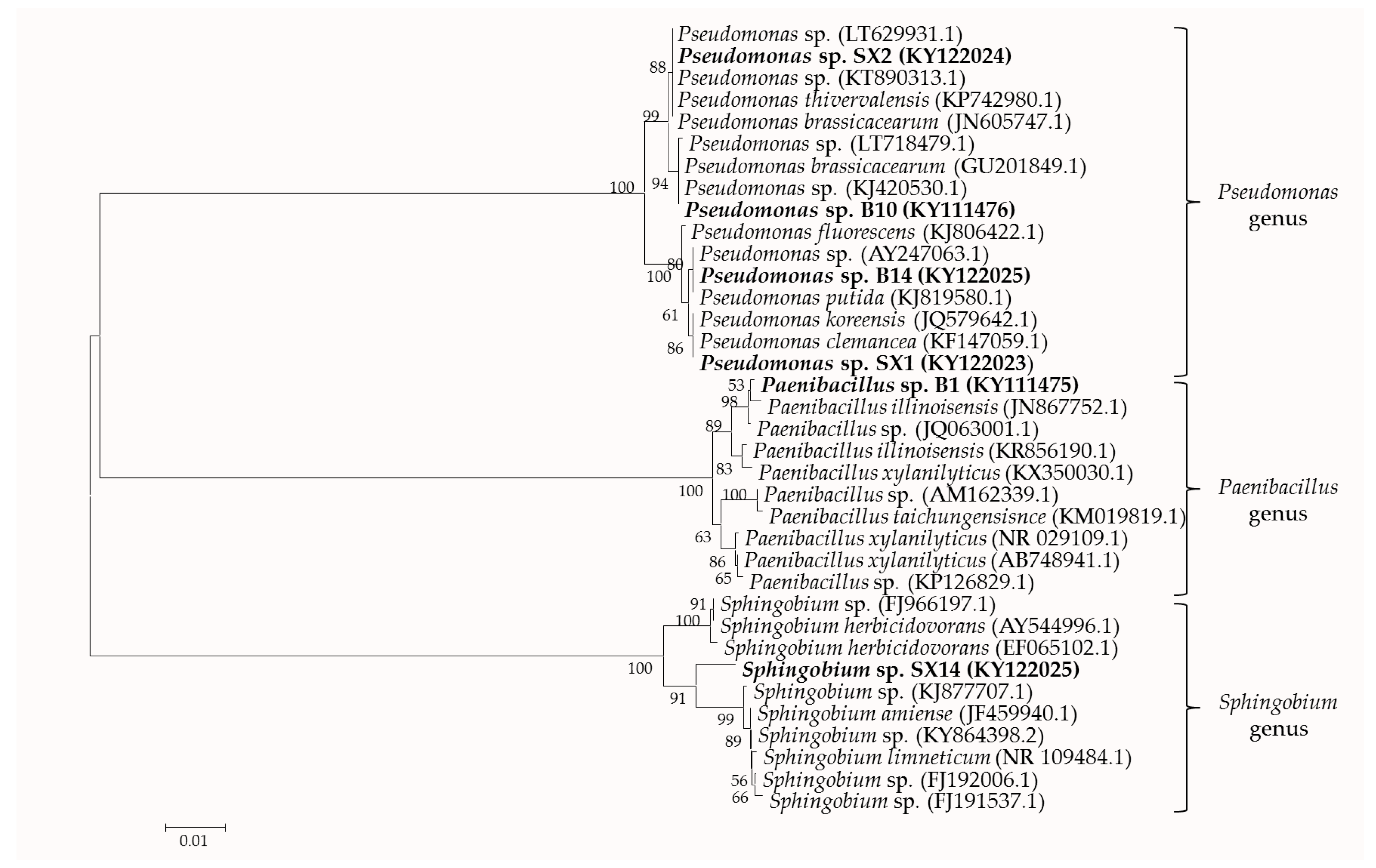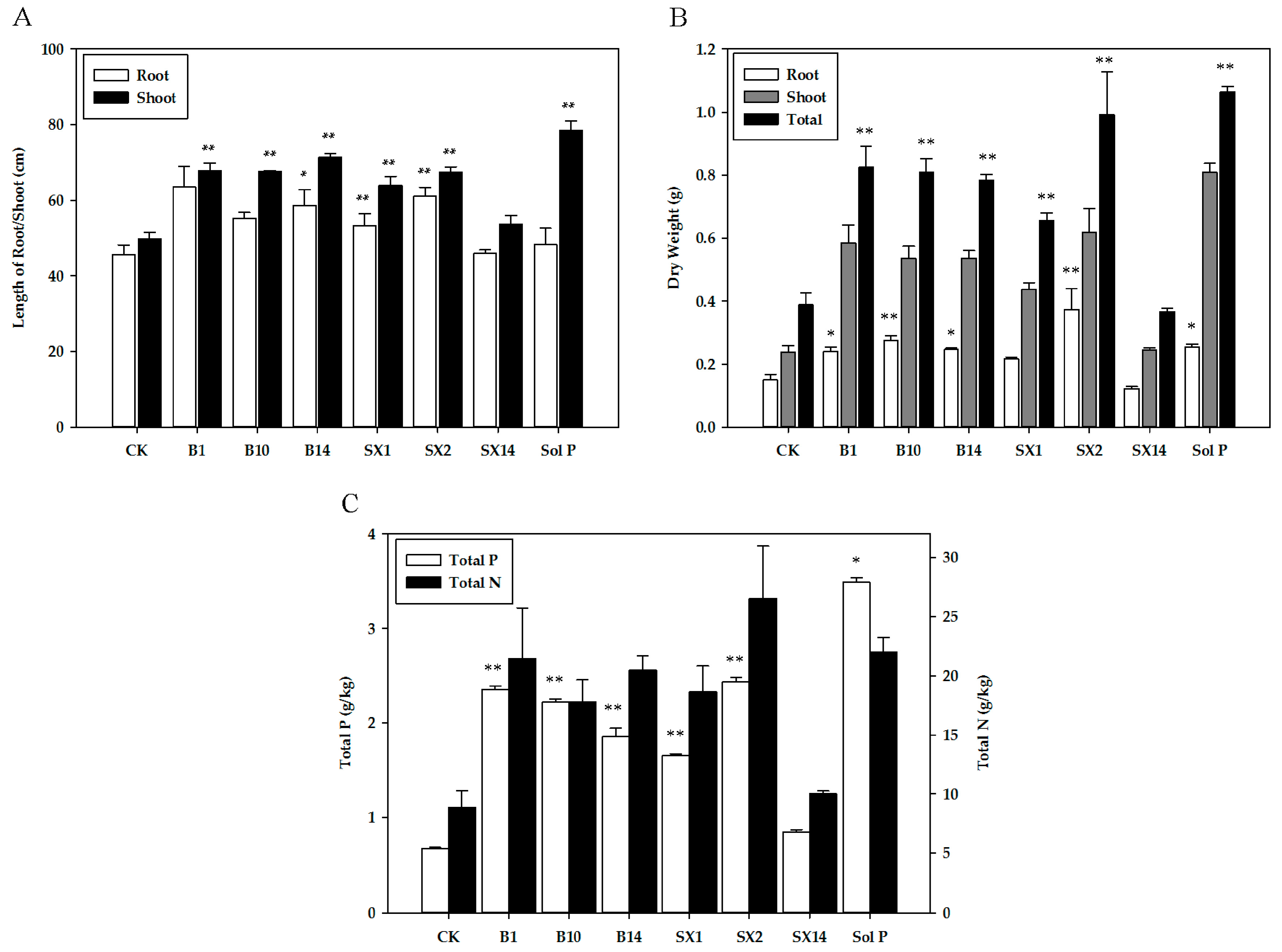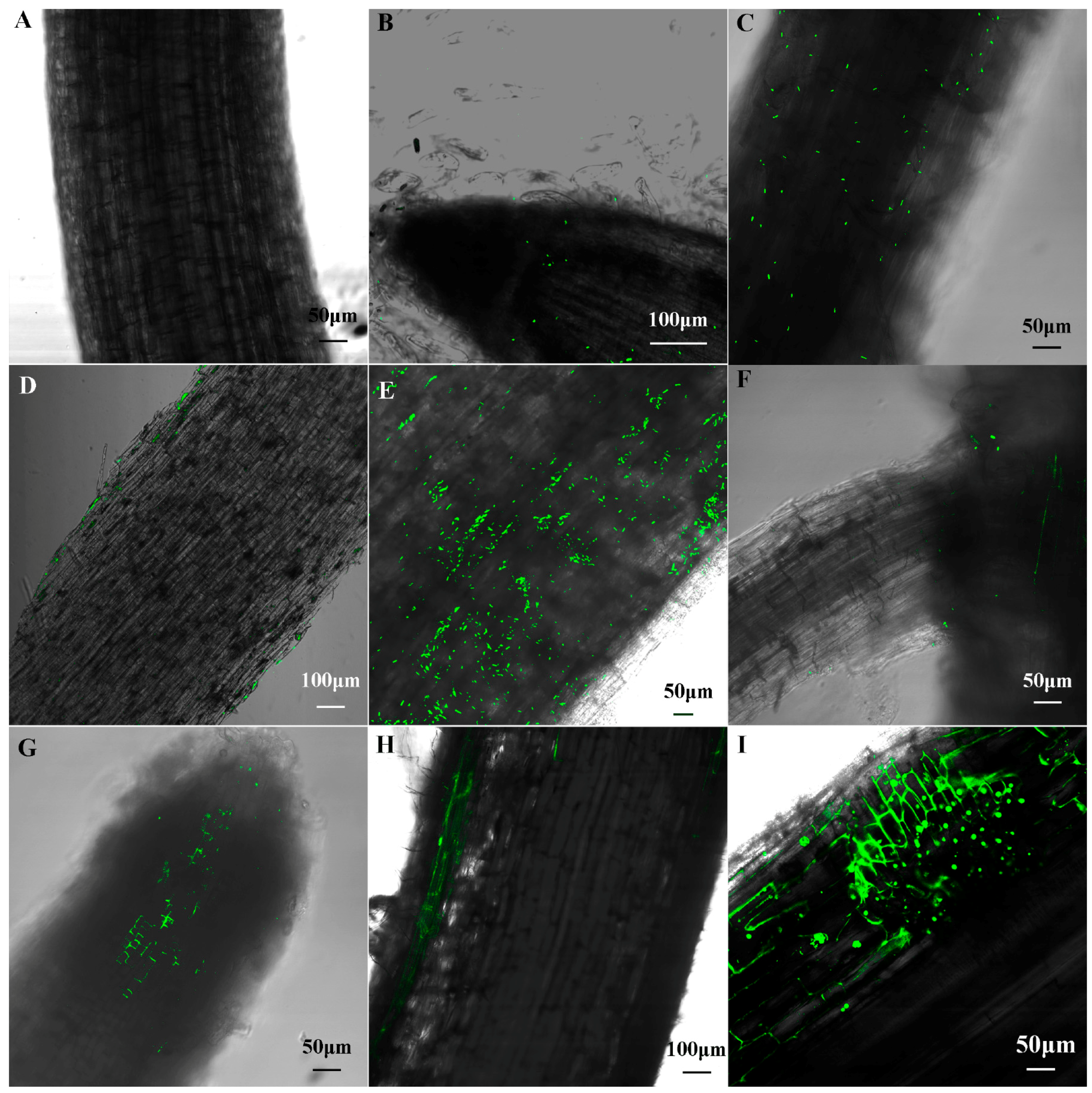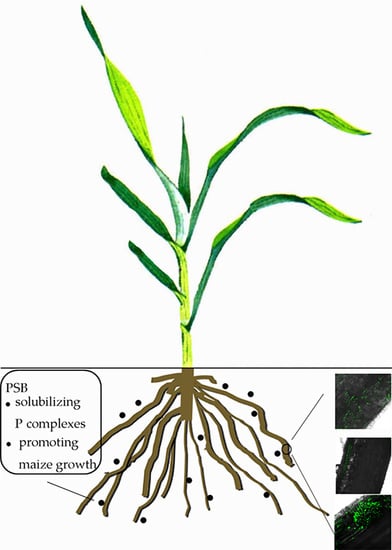Colonization and Maize Growth Promotion Induced by Phosphate Solubilizing Bacterial Isolates
Abstract
:1. Introduction
2. Results
2.1. Characterization and Identification of Isolated Phosphate-Solubilizing Bacteria
2.2. Qualitative and Quantitative Analysis of Phosphate Solubilization Ability of Isolated Phosphate-Solubilizing Bacteria
2.3. Growth Promotion Potential of Isolated Phosphate-Solubilizing Bacteria
2.4. Fluorescent Microscopy of GFP-Labelled Paenibacillus sp. B1 in Maize Root
3. Discussion
4. Materials and Methods
4.1. Soil Sampling and Phosphate-Solubilizing Bacteria Isolation
4.2. Morphological Characterization of Isolated Phosphate-Solubilizing Bacteria
4.3. Amplication and Sequencing of 16S rRNA Gene and Phylogenetic Analysis
4.4. Qualitative and Quantitative Determination of Phosphate Solubilization Ability of Isolated Phosphate Solubilizing Bacteria
4.5. Determination of Indole-3-Acetic Acid (IAA) Production
4.6. Growth Promotion Potential of Isolated Phosphate Solubilizing Bacteria
4.7. Colonization of Maize by GFP-Labelled B1
4.8. Statistical Analysis
5. Conclusions
Acknowledgments
Author Contributions
Conflicts of Interest
Abbreviations
| P | Phosphorus |
| N | Nitrogen |
| PSB | Phosphate solubilizing bacteria |
| CLSM | Confocal laser scanning microscopy |
| PGPR | Plant-growth-promoting rhizobacteria |
| PVK | Pikovskaya |
| PSI | Phosphate solubilization index |
| NBRIP | National Botanical Research Institute Phosphate |
| ISR | Induced systemic resistance |
| LSD | Least significant difference |
References
- Fan, X.; Tan, J.; Yang, J. Utilization of exotic tropical and subtropical maize germplasm. Southwest China J. Agric. Sci. 2000, 13, 107–111. [Google Scholar] [CrossRef]
- Vance, C.P. Symbiotic nitrogen fixation and phosphorus acquisition. Plant nutrition in a world of declining renewable resources. Plant Physiol. 2001, 127, 390–397. [Google Scholar] [CrossRef] [PubMed]
- Khan, M.S.; Zaidi, A.; Ahemad, M.; Oves, M.; Wani, P.A. Plant growth promotion by phosphate solubilizing fungi-current perspective. Arch. Agron. Soil Sci. 2010, 56, 73–98. [Google Scholar] [CrossRef]
- Lyu, Y.; Tang, H.L.; Li, H.G.; Zhang, F.S.; Rengel, Z.; Whalley, W.R.; Shen, J.B. Major crop species show differential balance between root morphological and physiological responses to variable phosphorus supply. Front. Plant Sci. 2016, 7. [Google Scholar] [CrossRef] [PubMed]
- Zou, X.M.; Binkley, D.; Doxtader, K.G. A new method for estimating gross phosphorus mineralization and immobilization rates in soils. Plant Soil 1992, 147, 243–250. [Google Scholar] [CrossRef]
- Singh, H.; Reddy, M.S. Effect of inoculation with phosphate solubilizing fungus on growth and nutrient uptake of wheat and maize plants fertilized with rock phosphate in alkaline soils. Eur. J. Soil Biol. 2011, 47, 30–34. [Google Scholar] [CrossRef]
- Tilman, D.; Cassman, K.G.; Matson, P.A.; Naylor, R.; Polasky, S. Agricultural sustainability and intensive production practices. Nature 2002, 418, 671–677. [Google Scholar] [CrossRef] [PubMed]
- Schindler, D.W.; Hecky, R.E.; Findlay, D.L.; Stainton, M.P.; Parker, B.R.; Paterson, M.J.; Beaty, K.G.; Lyng, M.; Kasian, S.E. Eutrophication of lakes cannot be controlled by reducing nitrogen input: Results of a 37-year whole-ecosystem experiment. Proc. Natl. Acad. Sci. USA 2008, 105, 11254–11258. [Google Scholar] [CrossRef] [PubMed]
- Gyaneshwar, P.; Kumar, G.N.; Parekh, L.J.; Poole, P.S. Role of soil microorganisms in improving P nutrition of plants. Plant Soil 2002, 245, 83–93. [Google Scholar] [CrossRef]
- Sharma, S.B.; Sayyed, R.Z.; Trivedi, M.H.; Gobi, T.A. Phosphate solubilizing microbes: Sustainable approach for managing phosphorus deficiency in agricultural soils. SpringerPlus 2013, 2, 587. [Google Scholar] [CrossRef] [PubMed]
- Hagin, J.; Hadas, A. Solubility of calcium phosphate in calcareous soils. Nature 1962, 193, 1211–1212. [Google Scholar] [CrossRef]
- Sashidhar, B.; Podile, A.R. Transgenic expression of glucose dehydrogenase in Azotobacter vinelandii enhances mineral phosphate solubilization and growth of sorghum seedlings. Microb. Biotechnol. 2009, 2, 521–529. [Google Scholar] [CrossRef] [PubMed]
- Cordell, D.; Drangert, J.O.; White, S. The story of phosphorus: Global food security and food for thought. Global. Environ. Chang. 2009, 19, 292–305. [Google Scholar] [CrossRef]
- Khan, M.S.; Zaidi, A.; Wani, P.A. Role of phosphate-solubilizing microorganisms in sustainable agriculture—A review. Agron. Sustain. Dev. 2007, 27, 29–43. [Google Scholar] [CrossRef]
- Ghyselinck, J.; Velivelli, S.L.; Heylen, K.; O’Herlihy, E.; Franco, J.; Rojas, M.; De Vos, P.; Prestwich, B.D. Bioprospecting in potato fields in the Central Andean Highlands: Screening of rhizobacteria for plant growth-promoting properties. Syst. Appl. Microbiol. 2013, 36, 116–127. [Google Scholar] [CrossRef] [PubMed]
- Naqqash, T.; Hameed, S.; Imran, A.; Hanif, M.K.; Majeed, A.; van Elsas, J.D. Differential response of potato toward inoculation with taxonomically fiverse plant growth promoting rhizobacteria. Front. Plant Sci. 2016, 7, 144. [Google Scholar] [CrossRef] [PubMed]
- Acevedo, E.; Galindo-Castañeda, T.; Prada, F.; Navia, M.; Romero, H.M. Phosphate-solubilizing microorganisms associated with the rhizosphere of oil palm (Elaeis guineensis Jacq.) in Colombia. Appl. Soil Ecol. 2014, 80, 26–33. [Google Scholar] [CrossRef]
- Rodriguez, H.; Gonzalez, T.; Goire, I.; Bashan, Y. Gluconic acid production and phosphate solubilization by the plant growth-promoting bacterium Azospirillum spp. Naturwissenschaften 2004, 91, 552–555. [Google Scholar] [CrossRef] [PubMed]
- Chung, H.; Park, M.; Madhaiyan, M.; Seshadri, S.; Song, J.; Cho, H.; Sa, T. Isolation and characterization of phosphate solubilizing bacteria from the rhizosphere of crop plants of Korea. Soil Biol. Biochem. 2005, 37, 1970–1974. [Google Scholar] [CrossRef]
- Rodriguez, H.; Fraga, R. Phosphate solubilizing bacteria and their role in plant growth promotion. Biotechnol. Adv. 1999, 17, 319–339. [Google Scholar] [CrossRef]
- Montenegro, A.; Zapata, F. Rape genotypic differences in P uptake and utilization from phosphate rocks in an Andisol of Chile. Nutr. Cycl. Agroecosyst. 2002, 63, 27–33. [Google Scholar] [CrossRef]
- Omar, S.A. The role of rock-phosphate-solubilizing fungi and vesicular-arbuscular-mycorrhiza (VAM) in growth of wheat plants fertilized with rock phosphate. World J. Microbiol. Biotechnol. 1997, 14, 211–218. [Google Scholar] [CrossRef]
- Khan, A.A.; Jilani, G.; Akhtar, M.S.; Naqvi, S.M.S.; Rasheed, M. Phosphorus solubilizing bacteria: Occurrence, mechanisms and their role in crop production. J. Agric. Biol. Sci. 2009, 1, 48–58. [Google Scholar]
- Chen, Y.P.; Rekha, P.D.; Arun, A.B.; Shen, F.T.; Lai, W.A.; Young, C.C. Phosphate solubilizing bacteria from subtropical soil and their tricalcium phosphate solubilizing abilities. Appl. Soil Ecol. 2006, 34, 33–41. [Google Scholar] [CrossRef]
- Zeng, Q.; Wu, X.; Wang, J.; Ding, X. Phosphate solubilization and gene expression of phosphate-solubilizing bacterium Burkholderia multivorans WS-FJ9 under different levels of soluble phosphate. J. Microbiol. Biotechnol. 2017, 27, 844–855. [Google Scholar] [CrossRef] [PubMed]
- Oteino, N.; Lally, R.D.; Kiwanuka, S.; Lloyd, A.; Ryan, D.; Germaine, K.J.; Dowling, D.N. Plant growth promotion induced by phosphate solubilizing endophytic Pseudomonas isolates. Front. Microbiol. 2015, 6, 745. [Google Scholar] [CrossRef] [PubMed]
- Kang, S.M.; Joo, G.J.; Hamayun, M.; Na, C.I.; Shin, D.H.; Kim, H.Y.; Hong, J.K.; Lee, I.J. Gibberellin production and phosphate solubilization by newly isolated strain of Acinetobacter calcoaceticus and its effect on plant growth. Biotechnol. Lett. 2009, 31, 277–281. [Google Scholar] [CrossRef] [PubMed]
- Bianco, C.; Defez, R. Improvement of phosphate solubilization and Medicago plant yield by an indole-3-acetic acid-overproducing strain of Sinorhizobium meliloti. Appl. Environ. Microbiol. 2010, 76, 4626–4632. [Google Scholar] [CrossRef] [PubMed]
- Gusain, Y.S.; Kamal, R.; Mehta, C.M.; Singh, U.S.; Sharma, A.K. Phosphate solubilizing and indole-3-acetic acid producing bacteria from the soil of Garhwal Himalaya aimed to improve the growth of rice. J. Environ. Biol. 2015, 36, 301–307. [Google Scholar] [PubMed]
- Jilani, G.; Akram, A.; Ali, R.M.; Hafeez, F.Y.; Shamsi, I.H.; Chaudhry, A.N.; Chaudhry, A.G. Enhancing crop growth, nutrients availability, economics and beneficial rhizosphere microflora through organic and biofertilizers. Ann. Microbiol. 2007, 57, 177–184. [Google Scholar] [CrossRef]
- Rahimzadeh, S.; Pirzad, A. Arbuscular mycorrhizal fungi and Pseudomonas in reduce drought stress damage in flax (Linum usitatissimum L.): A field study. Mycorrhiza 2017. [Google Scholar] [CrossRef] [PubMed]
- Monica, S.; Harshada, J. Study of phosphate solubilizing activity of lead tolerant Pseudomonas aeruginosa HMT 51 isolated from Zawar mines, Udaipur, India. Res. J. Recent Sci. 2015, 5, 280–282. [Google Scholar]
- Gupta, P.; Kumar, V. Value added phytoremediation of metal stressed soils using phosphate solubilizing microbial consortium. World J. Microbiol. Biotechnol. 2017, 33. [Google Scholar] [CrossRef] [PubMed]
- Prasher, D.C.; Eckenrode, V.K.; Ward, W.W.; Prendergast, F.G.; Cormier, M.J. Primary structure of the Aequorea victoria green-fluorescent protein. Gene 1992, 111, 229–233. [Google Scholar] [CrossRef]
- Valdivia, R.H.; Hromockyj, A.E.; Monack, D.; Ramakrishnan, L.; Falkow, S. Applications for green fluorescent protein (GFP) in the study of hostpathogen interactions. Gene 1996, 173, 47–52. [Google Scholar] [CrossRef]
- Reinhold-Hurek, B.; Hurek, T. Life in grasses: Diazotrophic endophytes. Trends Microbiol. 1998, 6, 139–144. [Google Scholar] [CrossRef]
- Liu, X.; Zhao, H.; Chen, S. Colonization of maize and rice plants by strain Bacillus megaterium C4. Curr. Microbiol. 2006, 52, 186–190. [Google Scholar] [CrossRef] [PubMed]
- Hao, T.; Chen, S. Colonization of wheat, maize and cucumber by Paenibacillus polymyxa WLY78. PLoS ONE 2017, 12, e0169980. [Google Scholar] [CrossRef] [PubMed]
- Wang, T. Analysis of the temperature of com production in North China. Hans J. Agric. Sci. 2013, 1, 28–29. [Google Scholar]
- Dobbelaere, S.; Vanderleyden, J.; Okon, Y. Plant growth-promoting effects of diazotrophs in the rhizosphere. Crit. Rev. Plant Sci. 2003, 22, 107–149. [Google Scholar] [CrossRef]
- Glick, B.R. The enhancement of plant growth by free-living bacteria. Can. J. Microbiol. 1995, 41, 109–117. [Google Scholar] [CrossRef]
- Senthilkumar, M.; Govindasamy, V.; Annapurna, K. Role of antibiosis in suppression of charcoal rot disease by soybean endophyte Paenibacillus sp. HKA-15. Curr. Microbiol. 2007, 55, 25–29. [Google Scholar] [CrossRef] [PubMed]
- Yazdani, M.; Bahmanyar, M.A.; Pirdashti, H.; Esmaili, M.A. Effect of phosphate solubilization microorganisms (PSM) and plant growth promoting rhizobacteria (PGPR) on yield and yield components of corn (Zea mays L.). World Acad. Sci. Eng. Technol. 2009, 49, 90–92. [Google Scholar]
- Peng, Z.; Liu, Y.; Li, Y.; Abawi, Y.; Wang, Y.; Men, M.; An-Vo, D.A. Responses of nitrogen utilization and apparent nitrogen loss to different control measures in the wheat and maize rotation system. Front. Plant Sci. 2017, 8, 160. [Google Scholar] [CrossRef] [PubMed]
- Shao-Yun, M.A.; Liu, Y.N.; Wang, Y.Q.; Qin, Y.N.; Liu, H.L.; Peng, Z.P. Study on the characters of living condition and nutrient balance of high-yield wheat and maize rotation system in Hebei province. J. Agric. Univ. Hebei 2015, 38, 8–13. [Google Scholar] [CrossRef]
- Deng, Z.S.; Zhao, L.F.; Kong, Z.Y.; Yang, W.Q.; Lindström, K.; Wang, E.T.; Wei, G.H. Diversity of endophytic bacteria within nodules of the Sphaerophysa salsula in different regions of Loess Plateau in China. FEMS Microbiol. Ecol. 2011, 76, 463–475. [Google Scholar] [CrossRef] [PubMed]
- Vrieze, M.D.; Pandey, P.; Bucheli, T.D.; Varadarajan, A.R.; Ahrens, C.H.; Weisskopf, L.; Bailly, A. Volatile organic compounds from native potato-associated Pseudomonasas potential anti-oomycete agents. Front. Microbiol. 2015, 6, 1295. [Google Scholar] [CrossRef] [PubMed]
- Zhou, T.; Chen, D.; Li, C.; Sun, Q.; Li, L.; Liu, F.; Shen, Q.; Shen, B. Isolation and characterization of Pseudomonas brassicacearum J12 as an antagonist against Ralstonia solanacearum and identification of its antimicrobial components. Microbiol. Res. 2012, 167, 388–394. [Google Scholar] [CrossRef] [PubMed]
- Nautiyal, C.S. An efficient microbiological growth medium for screening phosphate solubilizing microorganisms. FEMS Microbiol. Lett. 1999, 170, 265–270. [Google Scholar] [CrossRef] [PubMed]
- Johri, J.K.; Surange, S.; Nautiyal, C.S. Occurrence of salt, pH, and temperature-tolerant, phosphate-solubilizing bacteria in alkaline soils. Curr. Microbiol. 1999, 39, 89–93. [Google Scholar] [CrossRef] [PubMed]
- Louw, H.; Webley, D. A study of soil bacteria dissolving certain mineral phosphate fertilizers and related compounds. J. Appl. Microbiol. 1959, 22, 227–233. [Google Scholar] [CrossRef]
- Bashan, Y.; Kamnev, A.A.; Debashan, L.E. Tricalcium phosphate is inappropriate as a universal selection factor for isolating and testing phosphate-solubilizing bacteria that enhance plant growth: A proposal for an alternative procedure. Biol. Fertil. Soils 2013, 49, 465–479. [Google Scholar] [CrossRef]
- Gadagi, R.S.; Sa, T. New isolation method for microorganisms solulbilizing iron and aluminum phosphates using dyes. Soil Sci. Plant Nutr. 2002, 48, 615–618. [Google Scholar] [CrossRef]
- Collavino, M.M.; Sansberro, P.A.; Mroginski, L.A.; Aguilar, O.M. Comparison of in vitro solubilization activity of diverse phosphate-solubilizing bacteria native to acid soil and their ability to promote Phaseolus vulgaris growth. Biol. Fertil. Soils 2010, 46, 727–738. [Google Scholar] [CrossRef]
- Chaiharn, M.; Lumyong, S. Phosphate solubilization potential and stress tolerance of rhizobacteria from rice soil in Northern Thailand. World J. Microboil. Biotechnol. 2008, 25, 305–314. [Google Scholar] [CrossRef]
- Ahmad, F.; Ahmad, I.; Khan, M.S. Screening of free-living rhizospheric bacteria for their multiple plant growth promoting activities. Microbiol. Res. 2008, 163, 173–181. [Google Scholar] [CrossRef] [PubMed]
- Baig, K.S.; Arshad, M.; Shaharoona, B.; Khalid, A.; Ahmed, I. Comparative effectiveness of Bacillus spp. possessing either dual or single growth-promoting traits for improving phosphorus uptake, growth and yield of wheat (Triticum aestivum L.). Ann. Microbiol. 2012, 62, 1109–1119. [Google Scholar] [CrossRef]
- Bashan, Y.; Kamnev, A.A.; de-Bashan, L.E. A proposal for isolating and testing phosphate-solubilizing bacteria that enhance plant growth. Biol. Fertil. Soils 2013, 49, 1–2. [Google Scholar] [CrossRef]
- Yang, B.; Wang, X.-M.; Ma, H.-Y.; Jia, Y.; Li, X.; Dai, C.-C. Effects of the fungal endophyte Phomopsis liquidambari on nitrogen uptake and metabolism in rice. Plant Growth Regul. 2013, 73, 165–179. [Google Scholar] [CrossRef]
- Hallmann, J.; Quadt-Hallmann, A.; Mahaffee, W.F.; Kloepper, J.W. Bacterial endophytes in agricultural crops. Can. J. Microbiol. 1997, 43, 895–914. [Google Scholar] [CrossRef]
- Errampalli, D.; Leung, K.; Cassidy, M.B.; Kostrzynska, M.; Blears, M.; Lee, H.; Trevors, J.T. Applications of the green fluorescent protein as a molecular marker in environmental microorganisms. J. Microbilol. Methods 1999, 35, 187–199. [Google Scholar] [CrossRef]
- Zhen, Y. Bacillus megatherium WY4 labeled by GFP and its colonization in Chinese Cabbage (Brassica chinensis). J. Agric. Biotechnol. 2016, 24, 1925–1934. [Google Scholar]
- Pavlova, A.S.; Leontieva, M.R.; Smirnova, T.A.; Kolomeitseva, G.L.; Netrusov, A.I.; Tsavkelova, E.A. Colonization strategy of the endophytic plant growth promoting strains of Pseudomonas fluorescens and Klebsiella oxytoca on the seeds, seedlings and roots of the epiphytic orchid, Dendrobium nobile Lindl. J. Appl. Microbiol. 2017. [Google Scholar] [CrossRef] [PubMed]
- Pérez-García, A.; Romero, D.; de Vicente, A. Plant protection and growth stimulation by microorganisms: Biotechnological applications of Bacilli in agriculture. Curr. Opin. Biotechnol. 2011, 22, 187–193. [Google Scholar] [CrossRef] [PubMed]
- Timmusk, S.; Grantcharova, N.; Wagner, E.G. Paenibacillus polymyxa invades plant roots and forms biofilms. Appl. Environ. Microbiol. 2005, 71, 7292–7300. [Google Scholar] [CrossRef] [PubMed]
- Alagawadi, A.R. Associative effect of Rhizobium and phosphate-solubilizing bacteria on the yield and nutrient uptake of chickpea. Plant Soil 1988, 105, 241–246. [Google Scholar] [CrossRef]
- Vincent, J. A Manual for the Practical Study of the Root-Nodule Bacteria; Int. Biol. Prog. Handbook No. 15; Blackwell Scientific Publications: Oxford, UK, 1970. [Google Scholar]
- RM, S.; NR, K. Phenotypic characterization. In Methods for General and Molecular Bacteriology; Ghardt, P., Murray, R.G.E., Wood, W.A., Krieg, N.R., Eds.; ASM Press: Washington, DC, USA, 1994; pp. 607–657. [Google Scholar]
- Khan, A.L.; Waqas, M.; Kang, S.M.; Al-Harrasi, A.; Hussain, J.; Al-Rawahi, A.; Al-Khiziri, S.; Ullah, I.; Ali, L.; Jung, H.Y.; et al. Bacterial endophyte Sphingomonas sp. LK11 produces gibberellins and IAA and promotes tomato plant growth. J. Microbiol. 2014, 52, 689–695. [Google Scholar] [CrossRef] [PubMed]
- Shahid, M.; Hameed, S.; Tariq, M.; Zafar, M.; Ali, A.; Ahmad, N. Characterization of mineral phosphate-solubilizing bacteria for enhanced sunflower growth and yield-attributing traits. Ann. Microbiol. 2014, 65, 1525–1536. [Google Scholar] [CrossRef]
- Tamura, K.; Stecher, G.; Peterson, D.; Filipski, A.; Kumar, S. MEGA6: Molecular evolutionary genetics analysis version 6.0. Mol. Biol. Evol. 2013, 30, 2725–2729. [Google Scholar] [CrossRef] [PubMed]
- Premono, M.E.; Moawad, A.M.; Vleck, P.L. G. Effect of phosphate solubilizing Pseudmonas putida on the growth of maize and its survival in the rhizosphere. Indonasian J. Crop Sci. 1996, 11, 13–23. [Google Scholar] [CrossRef]
- Fiske, C.H.; Subbarow, Y. A colorimetric determination of phosphorus. J. Biol. Chem. 1925, 66, 375–400. [Google Scholar]
- Glickmann, E.; Dessaux, Y. A critical examination of the specificity of the Salkowski reagent for indolic compounds produced by phytopathogenic bacteria. Appl. Environ. Microb. 1995, 61, 793–796. [Google Scholar]
- Baker, W.H.; Thompson, T.L. Determination of total nitrogen in plant samples by Kjeldahl. In Plant Analysis Reference Procedures for the Southern Region of the United States; Plank, C.O., Ed.; Southern Cooperative Series Bulletin: Washington, DC, USA, 1992; pp. 13–16. [Google Scholar]
- Hanson, W.C. The photometric determination of phosphorus in fertilizers using the phosphovanadomolybdate complex. J. Sci. Food Agric. 1950, 1, 172–173. [Google Scholar] [CrossRef]
- Zhang, W.; Ding, Y.; Yao, L.; Liu, K.; Du, B. Construction of gene knock-out system for Paenibacillus polymyxa SC2. Acta Microbiol. Sin. 2013, 53, 1258–1266. [Google Scholar]
- Murashige, T.; Skoog, F. A revised medium for rapid growth and bio assays with tobacco tissue cultures. Phys. Plant. 1962, 15, 473–497. [Google Scholar] [CrossRef]




| Physiological Characteristics | Analysis of 16s rRNA Gene Sequence | |||||
|---|---|---|---|---|---|---|
| Strain Code | Location | Cell Morphology | Colony Morphology | Gram Stain | Maximum Similarity of 16S rRNA with (%) | Accession Number |
| B1 | BJ | Rods | White, regular | + | Paenibacillus illinoisensis | KY111475 |
| NR_113828 (99%) | ||||||
| B10 | BJ | Short rods | White, irregular | – | Pseudomonas thivervalensis | KY111476 |
| KJ420530 (99%) | ||||||
| B14 | BJ | Short rods | white | – | Pseudomonas fluorescens | KY111477 |
| KU977136 (99%) | ||||||
| SX1 | SX | Short rods | milky white | – | Pseudomonas koreensis | KY122023 |
| GQ368179 (99%) | ||||||
| SX2 | SX | Short rods | white | – | Pseudomonas syringae | KY122024 |
| KU977139 (99%) | ||||||
| SX14 | SX | rods | vitelline | – | Sphingobium mellinum | KY122025 |
| NR_133859 (98%) | ||||||
| Strain | Qualitative Analysis | IAA Production (mg L−1) | ||
|---|---|---|---|---|
| Diameter of Halo/cm | Diameter of Colony/cm | PSI | ||
| B1 | 0.56 ± 0.06 b | 0.40 ± 0.07 a | 2.46 ± 0.24 c | 20.30 ± 2.69 a |
| B10 | 0.59 ± 0.02 b | 0.12 ± 0.01 c | 5.78 ± 0.26 b | 8.97 ± 1.18 b,c |
| B14 | 0.95 ± 0.07 a | 0.15 ± 0.04 c | 7.64 ± 0.62 a | 5.84 ± 1.64 c |
| SX1 | 0.65 ± 0.08 b | 0.14 ± 0.04 c | 5.87 ± 0.49 b | ND |
| SX2 | 0.61 ± 0.02 b | 0.10 ± 0.01 c | 7.32 ± 0.35 a | 13.20 ± 2.32 b |
| SX14 | 0.31 ± 0.02 c | 0.30 ± 0.02 b | 2.03 ± 0.02c | 22.70 ± 3.37 a |
| Strain | NBRIP Medium with Ca3(PO4)2 | NBRIP Medium with AlPO4 | NBRIP Medium with FePO4 | NBRIP Medium with Lecithin | ||||
|---|---|---|---|---|---|---|---|---|
| Soluble P (mg·L−1) | PH | Soluble P (mg·L−1) | PH | Soluble P (mg·L−1) | PH | Soluble P (mg·L−1) | PH | |
| B1 | 378.0 ± 35.7 b | 5.17 ± 0.03 c | 95.2 ± 8.2 a | 3.13 ± 0.06 d | 23.0 ± 1.9 b | 3.52 ± 0.08 d | 0.4 ± 0.1 b | 4.28 ± 0.02 c |
| B10 | 208.9 ± 27.3 c | 5.06 ± 0.22 c | 9.5 ± 1.3 d | 3.51 ± 0.05 c | 16.0 ± 2.7 b,c | 3.07 ± 0.10 e | 2.0 ± 0.2 a | 3.58 ± 0.04 d |
| B14 | 307.8 ± 13.7 b | 5.07 ± 0.41 c | 23.4 ± 2.9 d | 3.28 ± 0.04 d | 4.6 ± 0.4 c | 4.12 ± 0.07 b | ND | 3.28 ± 0.02 e |
| SX1 | 493.1 ± 21.2 a | 4.03 ± 0.08 d | 56.0 ± 6.4 c | 3.59 ± 0.07 c | 17.1 ± 2.3 b | 3.91 ± 0.04 c | ND | 2.93 ± 0.04 f |
| SX2 | 529.7 ± 45.9 a | 5.49 ± 0.10 b,c | 73.0 ± 5.4 b | 4.11 ± 0.07 b | 47.2 ± 8.4 a | 4.09 ± 0.07 b | ND | 3.66 ± 0.03 d |
| SX14 | 71.7 ± 12.9 d | 5.82 ± 0.03 b | 16.4 ± 1.4 d | 3.62 ± 0.11 c | 16.2 ± 2.4b,c | 3.19 ± 0.08 e | ND | 4.75 ± 0.03 b |
| JM109 | ND | 6.43 ± 0.03 a | ND | 6.48 ± 0.06 a | ND | 6.63 ± 0.07 a | ND | 6.52 ± 0.18 a |
© 2017 by the authors. Licensee MDPI, Basel, Switzerland. This article is an open access article distributed under the terms and conditions of the Creative Commons Attribution (CC BY) license (http://creativecommons.org/licenses/by/4.0/).
Share and Cite
Li, Y.; Liu, X.; Hao, T.; Chen, S. Colonization and Maize Growth Promotion Induced by Phosphate Solubilizing Bacterial Isolates. Int. J. Mol. Sci. 2017, 18, 1253. https://doi.org/10.3390/ijms18071253
Li Y, Liu X, Hao T, Chen S. Colonization and Maize Growth Promotion Induced by Phosphate Solubilizing Bacterial Isolates. International Journal of Molecular Sciences. 2017; 18(7):1253. https://doi.org/10.3390/ijms18071253
Chicago/Turabian StyleLi, Yongbin, Xiaomeng Liu, Tianyi Hao, and Sanfeng Chen. 2017. "Colonization and Maize Growth Promotion Induced by Phosphate Solubilizing Bacterial Isolates" International Journal of Molecular Sciences 18, no. 7: 1253. https://doi.org/10.3390/ijms18071253





